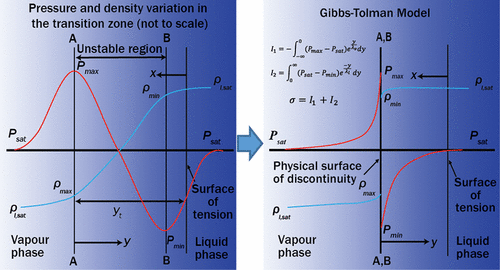Our official English website, www.x-mol.net, welcomes your
feedback! (Note: you will need to create a separate account there.)
Augmented Gibbs–Tolman Model for Surface Tension
Langmuir ( IF 3.7 ) Pub Date : 2017-09-20 00:00:00 , DOI: 10.1021/acs.langmuir.7b02041 Sukesh Tumram 1 , K. Kesava Rao 1 , M. S. Ananth 2
Langmuir ( IF 3.7 ) Pub Date : 2017-09-20 00:00:00 , DOI: 10.1021/acs.langmuir.7b02041 Sukesh Tumram 1 , K. Kesava Rao 1 , M. S. Ananth 2
Affiliation

|
Gibbs developed the thermodynamics of a liquid–vapor system by introducing the idea of a “dividing surface” a hypothetical surface that separates the system into two homogeneous phases. The area and curvatures of a conveniently chosen dividing surface, the “surface of tension”, are used to account for the effects of the smooth variation of properties across the actual transition layer between the phases. Tolman (1948, 1949) considered a more detailed model of the interfacial region and obtained expressions for surface tension (σ) and the location of the surface of tension. Based on qualitative arguments, Tolman’s model introduced a surface of tension, such that the pressure (P) increases from its saturation value (Psat) to a maximum value (Pmax) as the surface is approached from the vapor side and decreases from (Psat) to its minimum value (Pmin) as the surface is approached from the liquid side. Assuming an exponential decay of (P) away from the surface, Tolman obtained an explicit expression for (σ) in terms of Psat, Pmax, Pmin, and two length scales. In the this work, the Gibbs-Tolman (GT) model is used along with the Lee and Kesler (1975) equation of state. The model is augmented to take into account the effect of the density gradient in the transition zone and a 4-parameter augmented model (AGT model) is proposed. The GT and AGT models are shown to fit the data for 152 pure liquids with an absolute average deviation (AAD) of 4.91% and 2.02%, respectively. The corresponding AAD values for 57 liquid mixtures are 4.2% and 3.0% respectively. Arguments are also presented to counter some of the fundamental concerns that have been raised about the GT approach. Although the model correlates the data very well, one of the length parameters turns out to be persistently negative, and the reason for this behavior is not clear.
中文翻译:

增强的吉布斯-托尔曼表面张力模型
吉布斯通过引入“划分表面”的概念来发展液体-蒸汽系统的热力学,该表面是将系统分为两个均相的假想表面。方便选择的分隔表面(“张力表面”)的面积和曲率用于说明相之间实际过渡层上的属性平滑变化的影响。Tolman(1948,1949)考虑了界面区域的更详细模型,并获得了表面张力(σ)和张力表面位置的表达式。基于定性论证,托尔曼模型引入了张力表面,从而使压力(P)从其饱和值(P sat)增大到最大值(P max)。)当从蒸汽侧接近表面时,从(P sat)减小到其最小值(P min),而从液体侧接近表面。假设(P)远离表面呈指数衰减,Tolman就(P sat,P max,P min)获得了(σ)的明确表达式。,以及两个长度刻度。在这项工作中,Gibbs-Tolman(GT)模型与Lee and Kesler(1975)状态方程一起使用。考虑到过渡区中密度梯度的影响,对该模型进行了扩充,并提出了一个四参数扩充模型(AGT模型)。GT和AGT模型显示适合152种纯液体的数据,绝对平均偏差(AAD)分别为4.91%和2.02%。57种液体混合物的相应AAD值分别为4.2%和3.0%。还提出了一些论点,以解决有关GT方法的一些基本问题。尽管该模型很好地关联了数据,但长度参数之一却始终为负,并且这种现象的原因尚不清楚。
更新日期:2017-09-20
中文翻译:

增强的吉布斯-托尔曼表面张力模型
吉布斯通过引入“划分表面”的概念来发展液体-蒸汽系统的热力学,该表面是将系统分为两个均相的假想表面。方便选择的分隔表面(“张力表面”)的面积和曲率用于说明相之间实际过渡层上的属性平滑变化的影响。Tolman(1948,1949)考虑了界面区域的更详细模型,并获得了表面张力(σ)和张力表面位置的表达式。基于定性论证,托尔曼模型引入了张力表面,从而使压力(P)从其饱和值(P sat)增大到最大值(P max)。)当从蒸汽侧接近表面时,从(P sat)减小到其最小值(P min),而从液体侧接近表面。假设(P)远离表面呈指数衰减,Tolman就(P sat,P max,P min)获得了(σ)的明确表达式。,以及两个长度刻度。在这项工作中,Gibbs-Tolman(GT)模型与Lee and Kesler(1975)状态方程一起使用。考虑到过渡区中密度梯度的影响,对该模型进行了扩充,并提出了一个四参数扩充模型(AGT模型)。GT和AGT模型显示适合152种纯液体的数据,绝对平均偏差(AAD)分别为4.91%和2.02%。57种液体混合物的相应AAD值分别为4.2%和3.0%。还提出了一些论点,以解决有关GT方法的一些基本问题。尽管该模型很好地关联了数据,但长度参数之一却始终为负,并且这种现象的原因尚不清楚。











































 京公网安备 11010802027423号
京公网安备 11010802027423号